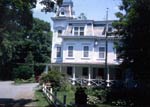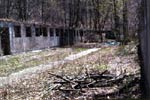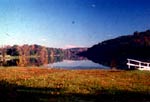
 NEW!
NEW! Picture postcards of
Shrub Oak and Mohegan.
Click here.

 NEW!
NEW!
Picture postcards of
Shrub Oak and Mohegan.
Click here.
An Illustrated History of
Mohegan Lake
Part 3: The Mohegan Resorts
By David O. Wright
This
feature is accompanied by a portfolio of photos of Lake Mohegan during the 20th
Century. Click here to view
the portfolio, or click an individual picture on this page to view an
enlargement. Parts 1 and 2 of the Illustrated History of Mohegan Lake are
available:
Click here to read
Part 1
Click here to read Part 2
 The late 1800s
and early 1900s saw Mohegan develop into a famous resort community. Lured by
easy train travel in a few hours, city residents could experience total rural
relaxation and a beautiful lake. Some ten resorts operated for 50 years,
offering lodging and first-rate entertainment. Among the more famous were the
Mohegan Country Club and Bungalow Colony, located on Route 6 (where the Lakeside
and Villas condominiums are now); The Sonoqua Lodge (Mohegan Avenue and
Christine, on the East side); Uncas
Lodge on Crown Island; Tall Timbers (Mohegan Avenue and Scofield on the East
side); Lakelawn Cottages (Mohegan Avenue on the East side); Rock
Hill Lodge (Holland Club property on the West side); the Shanty; the St.
Nicholas Hotel; and the Mohegan
Inn.
The late 1800s
and early 1900s saw Mohegan develop into a famous resort community. Lured by
easy train travel in a few hours, city residents could experience total rural
relaxation and a beautiful lake. Some ten resorts operated for 50 years,
offering lodging and first-rate entertainment. Among the more famous were the
Mohegan Country Club and Bungalow Colony, located on Route 6 (where the Lakeside
and Villas condominiums are now); The Sonoqua Lodge (Mohegan Avenue and
Christine, on the East side); Uncas
Lodge on Crown Island; Tall Timbers (Mohegan Avenue and Scofield on the East
side); Lakelawn Cottages (Mohegan Avenue on the East side); Rock
Hill Lodge (Holland Club property on the West side); the Shanty; the St.
Nicholas Hotel; and the Mohegan
Inn.
 In addition,
Mohegan Colony was established at the South end of the lake in 1930 as a utopian
attempt to provide an egalitarian way of living and raising one’s family. Part
of the Modern School movement, Mohegan Colony was a hotbed of new thinking. The
Colony established its own school, and had some 300 families. The homeowner
association survives, and strives to retain some of the history. However, in the
1950s, deeded restrictive covenants (which required people in that area to join
the homeowner association) expired after a court decision.
In addition,
Mohegan Colony was established at the South end of the lake in 1930 as a utopian
attempt to provide an egalitarian way of living and raising one’s family. Part
of the Modern School movement, Mohegan Colony was a hotbed of new thinking. The
Colony established its own school, and had some 300 families. The homeowner
association survives, and strives to retain some of the history. However, in the
1950s, deeded restrictive covenants (which required people in that area to join
the homeowner association) expired after a court decision.
 What all of them
had in common was the enjoyment of the lake, the centerpiece of their community.
Most had “swimming cribs” which provided a safe area within which to swim,
safe from the denizens of the lake depths, and allowing others to boat freely on
the lake. Children played games of finding colored stones on the bottom of the
lake-as the water was clear to depths of 10 feet or more. And, up to 1991, power
boats zoomed back and forth on the one mile long lake.
What all of them
had in common was the enjoyment of the lake, the centerpiece of their community.
Most had “swimming cribs” which provided a safe area within which to swim,
safe from the denizens of the lake depths, and allowing others to boat freely on
the lake. Children played games of finding colored stones on the bottom of the
lake-as the water was clear to depths of 10 feet or more. And, up to 1991, power
boats zoomed back and forth on the one mile long lake.
Late 1900s: Just Another Suburb
 As the century
wore on, however, people began to lose interest in Mohegan Lake. To relax,
people began to go to other resort communities in the Catskills and the
Adirondacks, and elsewhere. At the same time, the lake began to feel the effects
of so many people. The lake began to experience “eutrophication” - the
byproduct of civilization - and algae appeared more and more. By the 1970’s,
the lake was frequently unusable for pleasant swimming, and more development was
on the way.
As the century
wore on, however, people began to lose interest in Mohegan Lake. To relax,
people began to go to other resort communities in the Catskills and the
Adirondacks, and elsewhere. At the same time, the lake began to feel the effects
of so many people. The lake began to experience “eutrophication” - the
byproduct of civilization - and algae appeared more and more. By the 1970’s,
the lake was frequently unusable for pleasant swimming, and more development was
on the way.
In 1975, the Town of Yorktown approved yet further development on the lake - some 600 units of multifamily housing, all to be put on giant septic tanks.
 Mohegan
residents, now strong enough to constitute a year-round voting force, rebelled.
Led by a small group of local residents, they organized and sued the Town of
Yorktown - and won. Hiring an expert biologist, the residents argued that no
more development should be allowed on the lake until sewers were installed. Ken
Saum, Bob Potemski, and others, won a major victory which helped to preserve the
lake for future generations.
Mohegan
residents, now strong enough to constitute a year-round voting force, rebelled.
Led by a small group of local residents, they organized and sued the Town of
Yorktown - and won. Hiring an expert biologist, the residents argued that no
more development should be allowed on the lake until sewers were installed. Ken
Saum, Bob Potemski, and others, won a major victory which helped to preserve the
lake for future generations.
 The task is not
yet complete, but the continued organization of Mohegan Lake residents can help
to assure that the heritage which we have inherited will live on for future
generations. Since 1975, the Mohegan Lake District has served as a community
structure for the neighborhood. Jointly established by Yorktown and Cortlandt
after the residents’ big court victory, the District manages the lake, but its
meetings often allow different homeowner associations from around the lake to
share other information.
The task is not
yet complete, but the continued organization of Mohegan Lake residents can help
to assure that the heritage which we have inherited will live on for future
generations. Since 1975, the Mohegan Lake District has served as a community
structure for the neighborhood. Jointly established by Yorktown and Cortlandt
after the residents’ big court victory, the District manages the lake, but its
meetings often allow different homeowner associations from around the lake to
share other information.
 There are
currently several active homeowner associations or beach districts, most of
which operate swimming beaches on the lake. These include, from North to South
on the East side, Shrub Oak Lake Estates (SOLE), Mohegan Highlands, Mohegan
Beach Park, Alpine Woods, Amazon Beach and Mohegan Colony. The only active beach
on the West side is Section I.
There are
currently several active homeowner associations or beach districts, most of
which operate swimming beaches on the lake. These include, from North to South
on the East side, Shrub Oak Lake Estates (SOLE), Mohegan Highlands, Mohegan
Beach Park, Alpine Woods, Amazon Beach and Mohegan Colony. The only active beach
on the West side is Section I.
 In 1992, the Town
also agreed to preserve the Holland Sporting Club property - 15 acres jutting
out into the middle of the lake - for passive recreational use. The Town expects
to take title to the property shortly, but the future of the last of the great
Mohegan resort hotels, still in existence on the property, is in doubt. Current
plans are to bulldoze the structure.
In 1992, the Town
also agreed to preserve the Holland Sporting Club property - 15 acres jutting
out into the middle of the lake - for passive recreational use. The Town expects
to take title to the property shortly, but the future of the last of the great
Mohegan resort hotels, still in existence on the property, is in doubt. Current
plans are to bulldoze the structure.
Perhaps Lake Mohegan, born in the last great ice age 10,000 years ago, will continue to serve future generations of Mohegan Lake residents.
Note: This article is based on David's annual slide show presented at Lake Day in June; it is a work in progress, and David appreciates contributions of old photos, stories, and information. Photos can be scanned and returned. David can be reached at 962-1039.
Continuation in a series of predictions about the 20th Century from The Ladies Home Journal of December 1900 (click HERE for the complete list of predictions):
Prediction #9: “Photographs will be telegraphed from any distance. If there be a battle in China a hundred years hence snapshots of its most striking events will be published in the newspapers an hour later. Even to-day photographs are being telegraphed over short distances. Photographs will reproduce all of Nature’s colors.”
Prediction #10: “Man will See Around the World. Persons and things of all kinds will be brought within focus of cameras connected electrically with screens at opposite ends of circuits, thousands of miles at a span. American audiences in their theatres will view upon huge curtains before them the coronations of kings in Europe or the progress of battles in the Orient. The instrument bringing these distant scenes to the very doors of people will be connected with a giant telephone apparatus transmitting each incidental sound in its appropriate place. Thus the guns of a distant battle will be heard to boom when seen to blaze, and thus the lips of a remote actor or singer will be heard to utter words or music when seen to move.”
Predictions 1 through 8 can be found in feature articles starting with December 1999. Click here for a menu of past issues.
The Yorktown Historical Society updates the home page with seasonally appropriate articles and information. Click here to read our past issues.